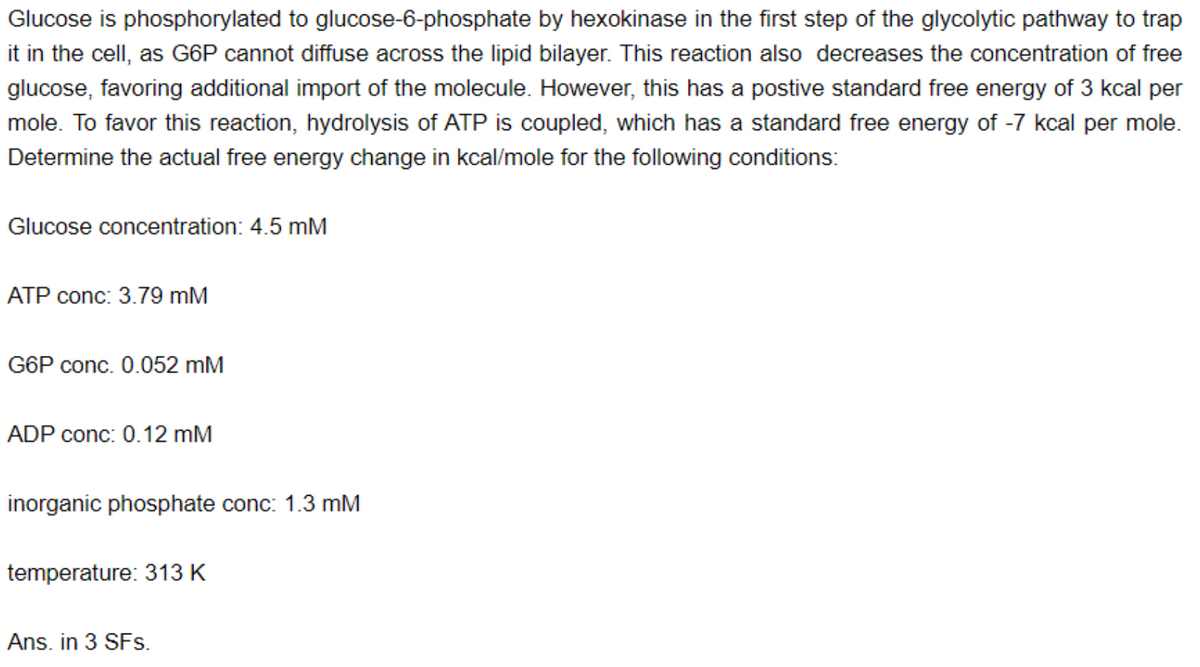Glucose is phosphorylated to glucose-6-phosphate by hexokinase in the first step of the glycolytic pathway to trap it in the cell, as G6P cannot diffuse across the lipid bilayer. This reaction also decreases the concentration of free glucose, favoring additional import of the molecule. However, this has a postive standard free energy of 3 kcal per mole. To favor this reaction, hydrolysis of ATP is coupled, which has a standard free energy of -7 kcal per mole. Determine the actual free energy change in kcal/mole for the following conditions: Glucose concentration: 4.5 mM ATP conc: 3.79 mM G6P conc. 0.052 mM ADP conc: 0.12 mM
Glucose is phosphorylated to glucose-6-phosphate by hexokinase in the first step of the glycolytic pathway to trap it in the cell, as G6P cannot diffuse across the lipid bilayer. This reaction also decreases the concentration of free glucose, favoring additional import of the molecule. However, this has a postive standard free energy of 3 kcal per mole. To favor this reaction, hydrolysis of ATP is coupled, which has a standard free energy of -7 kcal per mole. Determine the actual free energy change in kcal/mole for the following conditions: Glucose concentration: 4.5 mM ATP conc: 3.79 mM G6P conc. 0.052 mM ADP conc: 0.12 mM
Biochemistry
6th Edition
ISBN:9781305577206
Author:Reginald H. Garrett, Charles M. Grisham
Publisher:Reginald H. Garrett, Charles M. Grisham
Chapter27: Metabolic Integration And Organ Specialization
Section: Chapter Questions
Problem 20P: Figure 27.3 illustrates the response of R (ATP-regenerating) and U (ATP-utilizing) enzymes to energy...
Related questions
Question

Transcribed Image Text:Glucose is phosphorylated to glucose-6-phosphate by hexokinase in the first step of the glycolytic pathway to trap
it in the cell, as G6P cannot diffuse across the lipid bilayer. This reaction also decreases the concentration of free
glucose, favoring additional import of the molecule. However, this has a postive standard free energy of 3 kcal per
mole. To favor this reaction, hydrolysis of ATP is coupled, which has a standard free energy of -7 kcal per mole.
Determine the actual free energy change in kcal/mole for the following conditions:
Glucose concentration: 4.5 mM
ATP conc: 3.79 mM
G6P conc. 0.052 mM
ADP conc: 0.12 mM
inorganic phosphate conc: 1.3 mM
temperature: 313 K
Ans. in 3 SFs.
Expert Solution
This question has been solved!
Explore an expertly crafted, step-by-step solution for a thorough understanding of key concepts.
Step by step
Solved in 2 steps

Recommended textbooks for you

Biochemistry
Biochemistry
ISBN:
9781305577206
Author:
Reginald H. Garrett, Charles M. Grisham
Publisher:
Cengage Learning

Biochemistry
Biochemistry
ISBN:
9781305577206
Author:
Reginald H. Garrett, Charles M. Grisham
Publisher:
Cengage Learning